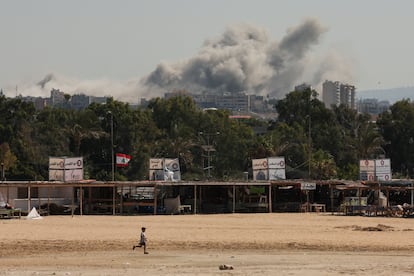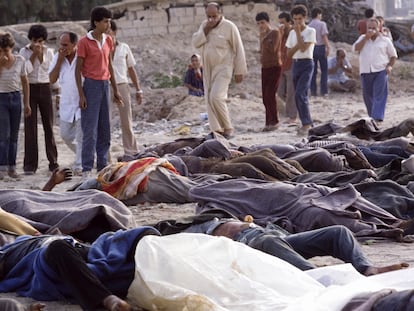Israel’s offensive in Lebanon: Bombings, evacuations and hundreds of deaths
The attacks of September 22-23 have already caused more fatalities in the country than all the other clashes this year

The Israeli military has carried out hundreds of airstrikes in Lebanon over the past three days, aiming to destroy Hezbollah’s infrastructure, killing at least 558 people as of Tuesday, more than in the entire year to date. The map below shows how Israeli missiles have reached beyond the border areas between the two countries, where reciprocal rocket fire had been more common since the start of the Gaza war in October 2023. The image shows the airstrikes verified by the Institute for the Study of War (ISW) and the unusual heat spots detected by satellites, which are good indicators of explosions caused by the strikes.
Bombardments in Lebanon between September 22 and 23
In what appears to be the same strategy Israel adopted before invading the Gaza Strip, these air strikes are taking place as military forces are building up on Lebanon’s southern border. It is also a leap into a new state of conflict, one that is much more intense and far-reaching. Israel claims to have hit 1,200 targets, mainly rocket launchers used by Hezbollah to reach its own territory. The bombs have reached Beirut, the capital, in a selective operation on the Dahiye neighbourhood, a Hezbollah stronghold, which targeted the militia’s senior leader Ali Karaki, head of the southern front (who is still alive, according to the militia).
Hezbollah responded to the attack with some 200 rockets, some of which hit northern Israel: anti-aircraft alarms were heard, especially in the Haifa area, according to local media.
The Israeli military has issued thousands of messages in Arabic on radio, in leaflets, on mobile phones and the internet, urging civilians in Lebanon to leave their homes. One recent message shows a map of the eastern governorates of Beqaa and Baalbek and reads: “If you are in or near a house that contains weapons for Hezbollah, you must leave and move away within two hours, to a distance of no less than 1,000 meters outside the village.” The towns in the area were the hardest hit by the shelling in the early hours of Tuesday, according to Lebanese news agencies.
The Lebanese health ministry says tens of thousands of people fled their homes in a single day, with no clear idea of their fate, or whether they will be able to return.
Hezbollah, Hamas’ ally in the Iranian-led “Axis of Resistance,” has been attacking areas in northern Israel since the latter invaded Gaza following the October 7 attacks a year ago. The Israeli army responded with rockets and missiles. It had also evacuated much of its population living near the border, where the attacks had so far been concentrated, as shown in the following map.
More people have died in the bombings of the past few days than in attacks on the border between the two countries so far this year, according to data from the Lebanon Ministry of Health and ACLED, an international organisation specializing in data on armed conflicts. The 558 deaths up to Tuesday represent the highest number in a single day since the end of the Lebanese civil war in 1990.
Although the conflict between the two countries has been ongoing for decades, the beginning of this new escalation can be traced to the end of July, when Israel blamed Hezbollah for a missile that hit a football field in the Golan Heights and killed 12 children. The Israeli army bombed the pro-Hezbollah suburb of Beirut, killing a senior militia member, and the day after, assassinated one of its top representatives, Ismail Haniyeh, while he was in Tehran with members of Hamas and the Houthis of Yemen, the other two Arab groups hostile to Israel that have the support of Iran and who were attending the inauguration ceremony for the new Iranian president, Masud Pezeshkian.
Last week, the explosion of hundreds of pagers and walkie-talkies in several Lebanese cities marked a further step in Israeli attacks on Arab territory, until the latest bombings, which in turn represent the beginning of a new phase in the conflict.
Sign up for our weekly newsletter to get more English-language news coverage from EL PAÍS USA Edition

